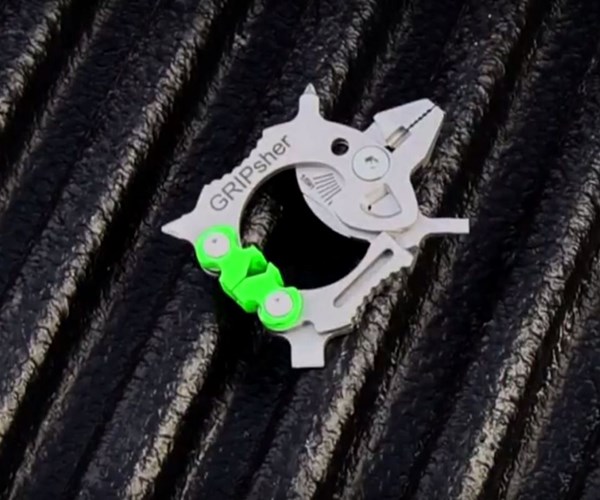Video: Multipurpose Tool Developed Using Various Operations
3D printing, waterjet, CNC machining and metal injection molding all figure into the journey this military-inspired invention has taken so far.
Share




Autodesk, Inc.
Featured Content
View More
Takumi USA
Featured Content
View More


ECi Software Solutions, Inc.
Featured Content
View More
Hwacheon Machinery America, Inc.
Featured Content
View MoreChristian Reed is an inventor, engineer and Army veteran currently trying to fund (through Kickstarter) his introduction of the compact multipurpose tool shown in the video above. He got the idea for this tool—the “Gripsher”—during his own recent overseas deployment. In the field, he had only a limited selection of tools available to him, so he began to imagine the design for a very small hand tool that could perform a large array of functions. That is, a tool that might be both easy and invaluable for a service member to carry.
To me, one of the interesting aspects of Mr. Reed’s experience with his invention is the number of different manufacturing processes he has already touched so far in the course of developing it. In his own words, here is the tool’s development story to this point. Mr. Reed says:
"At first, I was only able to do some drawings and make a few cardboard models with a utility knife. But when I returned from overseas in January, I began to use real tools to begin the prototyping process. Wanting to save money, I did quite a few 3D printer iterations to get the design down, but the desktop printer I was initially using couldn't accurately make parts this small. After I found a better 3D printer for this work, I was able to accurately and quickly make iterations, sometimes more than two in a day. Once we reached a design we were happy with, we decided to begin producing in metal.
To save time, we began just waterjet cutting a few samples to get a feel for what the parts would be like made of metal. We adjusted and used some 3D printed parts in conjunction with the metal parts to get a better feel for certain aspects of the tool’s functionality.
Since the tool would ultimately need to be made of stainless steel, we switched to getting parts machined at a job shop. The first round came out pretty well, considering that some of the cuts needed to made using a 1/32-inch end mill at a depth of 0.100 inch in 316 stainless. We made a few design changes and had another round made, this time in 17-4 PH stainless with laser engraving, some with black oxide coating. The results were great and we have been using these parts for testing and photo shoots.
Once we had the final design nailed down, we began to explore manufacturing options. CNC machining was ruled out due to fixturing complexity and the amount of small end mills that would be needed to mill each part. We began to explore metal injection molding and realized it would be a great fit for this product. We have been working with our manufacturer now to make three mold tools: one family mold for the left and right arm, one family mold for the knife and file tools, and a plastic injection mold for the green jaws at the bottom."
On Mr. Reed’s Kickstarter campaign, one of the support levels includes donation of a Gripsher tool to a U.S. service member as part of the reward. Learn more about that campaign.

Read Next
Registration Now Open for the Precision Machining Technology Show (PMTS) 2025
The precision machining industry’s premier event returns to Cleveland, OH, April 1-3.
Read More5 Rules of Thumb for Buying CNC Machine Tools
Use these tips to carefully plan your machine tool purchases and to avoid regretting your decision later.
Read MoreBuilding Out a Foundation for Student Machinists
Autodesk and Haas have teamed up to produce an introductory course for students that covers the basics of CAD, CAM and CNC while providing them with a portfolio part.
Read More





.png;maxWidth=150)

































